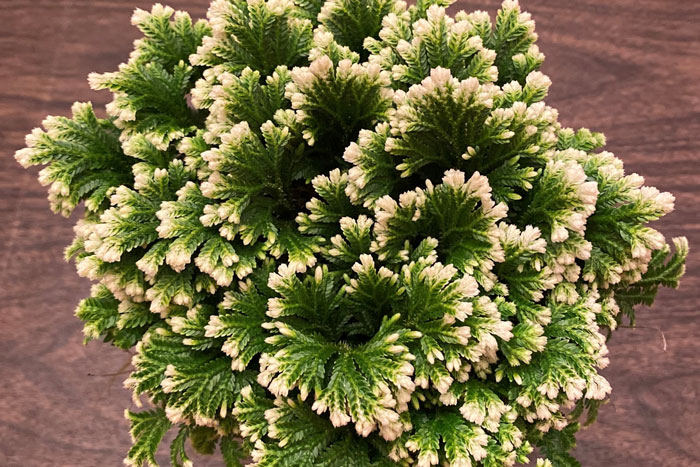Frosty Fern – also known as Selaginsella kraussiana “Variegatus” – is a popular Christmas plant because of its neutral, pleasing appearance and relatively easy maintenance. This plant makes the perfect plant for tiny planters and cute pots, whether you need it for the holidays or year-round. Please read the following guide to give your mini Frosty Fern the best possible care!

Light Requirements
When grown in indirect lighting conditions, Frosty Fern does best. During the hot summer months, it is important not to place your mini Frosty Fern in direct sunlight, as this will kill the plant quickly. If overexposed to light, it will wilt within a few hours. It can only tolerate early morning and late afternoon light.
As long as it has some shade, the Frosty Fern doesn’t require artificial light. If you notice that your plant is not getting enough light, you can move it to a window or part of the house that gets more light to resolve the issue.
Food, soil, and water requirements
Never let the Mini Frosty Fern dry out – it enjoys staying moist. The soil pH level should be between 5.5 and 6. This plant thrives in this range.
You should regularly check the soil of your mini plant for dryness. If the soil feels almost dry on the top, then it needs water. If your room has a low humidity level, you may need to water the plant several times a week.
You should use a liquid organic fertilizer such as 10-10-10 or 12-12-12. Prepare the fertilizer by adding 1/4 tsp of the fertilizer to 1 quart of water. You should not fertilize when the frond tips are white.
Trimming
To keep the plant appearing fresh, remove any leaves that have faded in color.
You can also opt to trim or completely remove any leaves that become too tangled throughout the growing season.
Use sharp scissors to cut off any undesirable leaves, but be cautious not to over prune your little Frosty Fern as this might harm the plant.
Taking Care Of Your Plant During The Fall And Winter
In the fall and winter months, like with other indoor plants, you’ll need to adapt your care requirements to ensure that your Frosty Fern thrives despite the change in seasons.
Reduce your watering amount by roughly half once the fall weather arrives. You’ll also want to keep an eye on the humidity level to make sure your plant doesn’t dry out too much.
To avoid wilted and brown lives, the humidity should be around 50% or more. You may simply maintain proper moisture levels by spraying your plants once a day with distilled water, using a humidifier, or utilizing a humidity tray.
Common Issues
Mini Frosty Fern is not susceptible to illness or pests in most cases. If your plant is exposed to temperature extremes, direct sunshine, or low humidity, it may suffer from problems. Look for weak foliage, dried out or browned leaves, or yellow leaves, since these are all signs of dryness or sunburn.
To resolve this issue, relocate the plant to a shady location and water it regularly while you wait for it to regain its previous shine. The temperature should not dip below 50 degrees Fahrenheit for indoor plants, which should not cause fungal growth.
Frequently Asked Questions About Frosty Ferns
How do you care for a frosty fern indoors?
It is best to keep frosty ferns in an environment where the temperature does not fall below 50 degrees Fahrenheit. The air above 80 can harm it. It prefers temperatures in the mid-60s or low 70s. During dry spells, water the soil thoroughly. Maintain an even moisture level.
Should You Mist a Frosty Fern?
It needs moist, well-drained soil, deep shade, temperatures between 68 and 84 degrees, 77 to 88 percent humidity, and no misting. Most of these requirements make for a recipe for disaster for a frosty fern inside the average household.
How Much Sun Does a Frosty Fern Need?
The frosty fern prefers bright light with an indirect source. Outside, it prefers shade. Additionally, they prefer a pH level between 5.5 and 6 as well as well-drained but continuously moist soil.
How Do You Save a Dying Frosty Fern?
A limp plant, dried-out leaves, or yellow leaves are all signs of dryness or sunburn. This problem can be resolved by moving the plant to a shaded area and watering it regularly until the plant regains its luster.
When Should I Repot My Frosty Fern?
Transplants should be done every spring. Choose a pot that’s two inches bigger or two inches deeper than what you currently have. Use quality soil and a pot with drainage holes.
How Do You Propagate a Frosty Fern?
The easiest way to multiply selaginella ‘Frosty’ is by stem cuttings: just press a section of the stem into moist soil, then maintain high humidity by covering the container with a dome or plastic bag. Within a week or two, it will root.